By Zeynep Şahin Mencütek (Swedish Research Institute, Istanbul).
Conducting fieldwork is a way of collecting data, verifying hypotheses, answering key questions and filling in gaps. It is also a key to gaining different visions about the themes and arguments, which have been proposed in the designation stage of the social research. Beyond fulfilling these research tasks, I find fieldwork to be a personally very enriching experience as a political scientist. My last field work in Şanlıurfa, Turkey this summer validated my ideas about the benefits of field research. I was in this province to conduct micro and meso level interviews within the context of RESPOND. After busy, tiring and stressful days in the field, I ended up with more questions than answers, the collection of life stories, unfinished sentences, but deep meaningful looks and heart touching scenes. So, this field research –similar to my earlier experiences- became a merger of emotional experiences with the scholarly endeavour. More than what I learned from semi-structured interviews, to be honest, I was enlightened by the experience itself and ordinary daily conversations.
Şanlıurfa is a province sharing the longest border with Syria and has three official border gates, namely Akçakale, Mürşitpınar, and Ceylanpınar in different towns of the province. It has become quite an important site for the settling of Syrian refugees in Turkey since 2011. Although it is a relatively less visible and less studied province in the context of refugee research in Turkey (compared to Gaziantep), it hosts more Syrian refugees than Gaziantep. As of August 2018, Şanlıurfa hosts 470,296 Syrians according to official statistics of Turkey’s Directorate General of Migration Management (DGMM), while the province’s population is 1,985,753, making Syrians 23.6% of the total population. Only other two border provinces, Kilis and Hatay host a higher per capita concentration of Syrian refugees than Şanlıurfa does, 95,5% and 28,06% respectively, while this concentration is 3,75 in İstanbul which hosts 564,189 Syrians, the highest number among Turkish provinces.[i] Şanlıurfa also has three refugee camps (officially called temporary shelter/accommodation centers), which host 67,682 Syrians, the highest number among the other nine provinces having similar camps.[ii] Until 2011, Şanlıurfa could be characterized as a province of internal emigration, but the Syrian civil war substantially changed the character and demography of the city. Not only having a border city but also having a high number of Arabic and Kurdish speaking locals made the city an attractive place for Syrians to arrive and settle town, even though the province has very limited job opportunities, and mainly has an agriculture-based economy.
My fieldwork occurred between July 10th and August 2nd in Şanlıurfa’s most crowded three towns, namely Eyyübiye, and Haliliye which are at the city center, as well as Siverek which is 95 kilometers away from the city center.[iii] I also paid a short visit to another town, Ceylanpınar, which is a border town having both a border gate and a crowded camp (hosting around 22,000 refugees). In Ceylanpınar and Siverek, I also found an opportunity to interview Syrian refugees living in rural areas which provided insights about rural-urban comparison.
In the month-long fieldwork, I was able to conduct 34 interviews with meso-level actors and 24 interviews with Syrian refugees. Semi-structured interviews took place from 20 minutes to 2 hours, conducted in Turkish, English, Arabic and Kurdish. I was lucky to work with a very handy translator and cultural mediator, Ali Akbaba who definitely eased my work in the city center. I was not that lucky in terms of weather, which was around 50C and which made going around quite difficult. I have a full range of observations about the response of Şanlıurfa to the Syrian mass migration, which I would like to share, but it is not possible considering the limits of this blog entry. It may be useful to share a few of them in line with the thematic focus of the RESPOND to give you a sense of the refugee situation in the province, leaving broader discussions to the reports and publications.
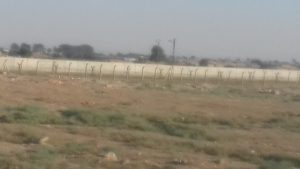
Turkey-Syria border, border wall, photo taken in Ceylanpınar by the author on 22 July 2018.
In terms of border controls, both micro and meso level actors in the province reported that it was very easy to cross the Turkey-Syria border with or without passports until 2015. Very few interlocutors stated that they encountered difficulty or any type of violence during their crossing to Turkey, except in cases in which they face armed militias on their journey inside Syria. Particularly, my interviews with locals in Ceylanpınar, and a site-visit to the border gate and border fences provided a better understanding of how the “open border” policy worked in practice and how close Turkish and Syrian towns are. Also, interviews demonstrated how the situation on the other side of the border was desperate and urged Syrians to flee. In the words of a local, “even dogs, cats and birds fled from Rasulayn (Syrian border town) to here due to the bombings, they got very afraid, we also heard all these bombardments for three years, our windows broke down, at least ten local people from our town died due to the shelling.”[iv]
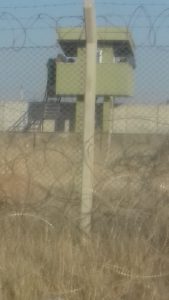
Border monitoring tower of Turkish soldiers, photo taken in Ceylanpınar by the author on 22 July 2018.
Since 2015, it seems that not only fighting on the border cooled down, but also the Turkish state gave up its open door policy. There have been more controls on the part of the state and new measures, but according to the interlocutors, it is not impossible to cross if smugglers are well paid and risks are taken. I made a visit to a town to see one of these new measures, a “security wall” which is modular and four-meters high. I was told that “a few holes under the wall were already opened and villagers help those who wish to cross these holes.”[v] As a local man wisely put it, “a smuggler is a person who becomes a smuggler if there is an opportunity to do so.” It seems there are still some opportunities for smugglers. Nevertheless, border crossings are very limited compared to “the mass crossings of hundreds of thousands on daily basis” in the first four years of the war. [vi]
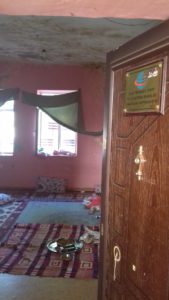
A Syrian couple with two kids from Kobani were given the old school of the village to settle down by the muhtar. They are not supposed to pay rent which gives them financial relief. Photo taken in Karakoyun village at Siverek by the author on 15 July 2018.
Another dimension of border controls is returns. During my interviews and site visits, voluntary return does not seem as pertinent even though many Syrians expressed their willingness if conditions in Syria become safe and liveable, while locals have been very much looking for the urging of Syrians’ return by Turkish state authorities. An answer of a local authority (muhtar) to my question about integration was: “integration? Do you mean their long-term stay here? The only solution is the quick return of all Syrians.”[vii] I came across some exceptions to the current practices about voluntary return. During my visit to the village of Siverek, Karakoyun, I learned that 200 families fled to this village from Kobani at the end of 2014, but almost all of them except two families returned their home in Syria within two years. My interviews with the remaining two families who settled in the old school building made it clear that these families did not return as they do not have financial resources over there and plan to go back if they accumulate money to buy a house in Kobani. Moreover, I heard about the forced return of dozens of male Syrians, including detention for the purpose of return, which happens if there is an alleged accusation regarding a person’s links with any terrorist organizations. Such returns are organized with the cooperation of the DGMM and the Security Forces and take place in a short time period, such as in a week.
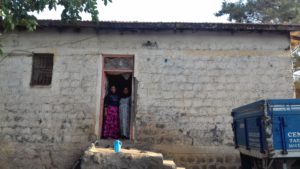
A female local villager and a Syrian refugee. Local villagers provided food and other material aid to the Syrian refugee family since 2014. A friendship and integration are observable in the relations among them. Photo taken in Karakoyun village at Siverek by the author on 15 July 2018.
RESPOND’s other thematic focus is on reception. In the case of Şanlıurfa, the main providers of the first material needs of Syrians (such as house equipment) used to be local communities, including neighbours, previously arrived family members and relatives from same ethnicity or tribes. Local community-based humanitarianism is very much observable in the province. There has been also growing institutional humanitarianism with the arrival or establishment of a plethora of INGOs, NGOs, faith-based local NGOs, as well as community organizations established by Syrians. Although interviewed representatives from these organizations reported delivering assistance, very few refugees said that they received kind or cash aid from such organizations, while many reported getting aid from neighbours. The most beneficial institutional social assistance is the debit card that is provided monthly by the Turkish Red Crescent with the funding of UN’s Emergency Social Safety Net program as well as cash assistance to school children. Informal work and these debit cards seem to be the main livelihood source for many of them. Registration and accessing to ID cards has often been an easy process for Syrians.
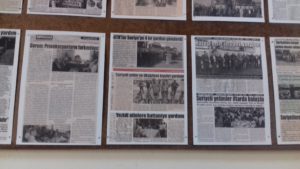
News about the humanitarian assistance provided by Şanlıurfa İnsani Yardım Platformu (Humanitarian Aid Platforms), which is an umbrella organization of 84 local NGOs. Photo taken in Şanlıurfa city center by the author on 29 July 2018.
Refugee camps are also a vital part of reception policies. I have visited a tent camp in Ceylanpınar. As opposed to international and Turkish authorities’ description of camps as “five-star camps”[viii] or being an example for “how to build a perfect refugee camp,”[ix] what I visited is barely satisfactory. It is a tent camp with an extremely poor infrastructure, particularly a bad road and common bathrooms, a small tent school without any garden or playground, but a high level of surveillance in and outside of the camp. Although these conditions may be thought of as acceptable in the first two years, it is not acceptable in the seventh year of refugee hosting. It may be the case that infrastructure was fine when it was established but it definitely, needs renovation. I was told that there are around 18,000-22,000 refugees living there, in summer time the numbers decrease because camp residents undertake seasonal agricultural labor with their families.
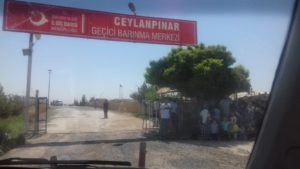
Entrance of Ceylanpınar tent camp. Photo taken in Ceylanpınar by the author on 23 July 2018.
Another thematic emphasis of RESPOND is on protection. This theme is increasingly on the agenda in Şanlıurfa. This is not only because the province has a large refugee population, but also many international NGOs opened their branches or extended their programs there. They and national NGOs have a strong protection dimension and almost all have case management programs providing individual mental health and socio-psychological support as well as community centers providing community empowerment. Moreover, the Turkish Red Crescent and Provincial Director of Family and Social Policies Ministry whom I also met, have been quite active in collaborating with INGOs as he considers that “all these INGOs operate in fields which fall under the ministry’s service area and it is important to know what they are doing on the ground.”[x] Prevention of child labor and education of children are two safe areas where INGOs and provincial state authorities sought ways to collaborate effectively.
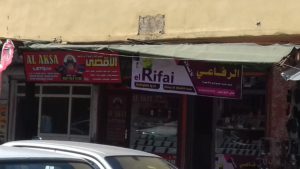
Two cell-phone store owned by Syrian refugees in a neighbourhood where Syrians live in high numbers at the city center of Şanlıurfa. Photo taken by the author on 28 August 2018.
Integration is also another policy field which RESPOND is trying to understand in local, national and regional levels. Şanlıurfa is a promising micro context to explore integration experiences, actors and factors involving the refugee integration process. The common language (either Arabic or Kurdish), kinship, religious belonging (to Islam), and conservative worldview appear as important facilitators of integration of Syrians into Şanlıurfa. Almost no one I interviewed reported difficulties about accessing health services. Unlike in other cities, such as İzmir and İstanbul, language does not appear as a barrier to get proper health services. Education services, particularly primary and secondary level education, are accessible to many Syrian children through temporary education centers. I visited three of them in different locations (in the city center, a camp and Siverek). Also, I was told that Syrian students who learned Turkish pursue education with their Turkish peers. According to the Provincial Vice Director of the Ministry of Education, in two years, all temporary education centers, including those in the camps will finish their mission and all Syrian students will be able to pursue education with their Turkish peers. While health care and education are not challenges for Syrians, it is not the case for access to the labour market. The city has a high unemployment rate, and this was exacerbated by the arrival of Syrians. Nevertheless, many interviewed Syrians reported that they have been working in informal jobs in various sectors. Construction and agriculture are the two sectors, which hire the highest numbers of Syrians, but these are the sectors in which exploitation and insecurity are the most common. Many Syrians opened small stores and some medium-size companies in the province, signalling capital in-flow. Also, the province has high numbers of Syrian teachers, lawyers, dentists and doctors. Many are able to work in temporary and informal jobs. Local authorities take a flexible approach towards these types of entrepreneurs considering that “without cash assistance and working opportunities, there may be more tensions between locals and Syrians in the province.”[xi] Interviews with Syrians from different class backgrounds demonstrated that class positively influences the relationships with locals and eliminates challenges about housing and access to sustainable livelihoods. While locals’ social acceptance of Syrians seems positive, their concerns about them focus on crowdedness in the province, sharing parks with them, the rise of polygamy due to Syrian women marrying local men and the make-up that Syrian women wear. However, it is possible to smell increasing reluctance of locals to live with Syrians.
During RESPOND’s kick-off meeting in Turkey, Prof. Ayhan Kaya raised the question of hope in the picture of refugee integration, and I am adding there is also resistance and empowerment. I am sharing some scenes which I observed to give you food for thought for hope, resistance and empowerment which touched my heart:
– I met a young Syrian girl who lived with her parents and seven siblings (including a disabled brother) in a very small and extremely hot house. She has just completed her first year in the Nursing Department of the Harran University. She has taken a fellowship which she shared with her sister who is also the second year student in the Computer Engineering Department of a university in another Turkish city.
– I met a Syrian middle-aged painting teacher and a Syrian dentist. Both are seeking ways to form an association and build ties with unions for protecting the rights of Syrian teachers and dentists.
-I met two very young men who opened a telecommunication company which hired 15 Syrian young engineers. They were planning to open a new branch in İstanbul. They have just been granted Turkish citizenship, which is expected to ease the bureaucratic hurdles they must deal with.
-I met a famous photographer from Rakka. Despite all the challenges and difficulties he faced, he has been continuously searching for how he may open a photo exhibition. Fortunately, the Swedish Research Institute Istanbul will give him an area in which to exhibit this fall.
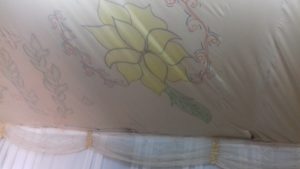
Inside of a refugee tent, Photo taken in Ceylanpınar by the author on 23 July 2018.
-I met a very lovely family in the refugee camp with two children. They transformed their 20-30m2 size tent into their home and a store. As you can see in the picture, the wife decorated the roof of the tent with her beautiful drawings; she made a small kitchen and garden with some greenery, and the husband made a very small but orderly bicycle repair shop in the front side of tent where he earns a little money.
Many more scenes are coming to mind, with some hope in them. In general, I felt the desperation of just asking questions but not contributing to the lives of refugees directly. I was very much afraid to create an expectation which I cannot fulfil, but also I again observed how strong and resistant human beings are under very challenging conditions.
[i] Distribution of Syrians in the Scope of Temporary Protection by Province, http://www.goc.gov.tr/icerik6/temporary-protection_915_1024_4748_icerik. Accessed 18 August 2018.
[ii] Distribution of Syrians in the Scope of Temporary Protection by Temporary Shelter Centers, http://www.goc.gov.tr/icerik6/temporary-protection_915_1024_4748_icerik. Accessed 18 August 2018.
[iii] Şanlıurfa İlçelerinin Nüfusu, https://www.nufusu.com/ilceleri/sanliurfa-ilceleri-nufusu. Accessed 18 August 2018
[iv] Daily conversation with two local women in Ceylanpınar, 22 august 2018.
[v] Interview with a local representative in Ceylanpınar, 23 August 2018.
[vi] Interview with a local representative in Ceylanpınar, 23 August 2018. Interview with a journalist who served in the reception at the Suruc, Akçakale border Gates in the 2014, Şanlıurfa, 25 August 2018.
[vii] Interview with muhtar in Eyyubiye, Şanlıurfa, 18 August 2018.
[viii] Erol Cebeci and Sally Judson, “Syrian Refugees in Turkey”, 4 April 2014, http://setadc.org/syrian-refugees-in-turkey-2/.
[ix] “How to build a perfect refugee camp” New York Times, Accessed 19 August 2018. https://www.nytimes.com/2014/02/16/magazine/how-to-build-a-perfect-refugee-camp.html. Accessed 19 August 2018
[x] Interview with the provincial director of the Family and Social Policies Ministry, in Şanlıurfa, 26 August 2018.
[xi] Interview with the muhtar of the neighborhood where Syrians live in high numbers and opened many small stores, 18 August 2018.

Thank you Zeynep,
for the informative and rick fieldwork notes. It is interesting to read about the resiliency found among refugees, I believe expressed through hope, goals, and achievements they express. This is close to many other refugees, but not often found in studies about migration.